Seismic Mitigation of Curved Continuous Girder Bridge Considering Collision Effect
Abstract
:1. Introduction
2. Bridge Analysis Model
2.1. Bridge Main Structure Model
2.2. Contact Collision Simulation
2.3. Seismic Mitigation and Unseating Prevention Devices
3. Dynamic Analysis Method and Ground Motion Input
4. Seismic Response Analysis
4.1. Contact Force between Adjacent Structures at the Expansion Joint
4.2. Contact Stress of the Contact Surface of the Expansion Joint
4.3. Damage to Adjacent Structures at Expansion Joints
4.4. The Number of Collisions at the Edge of Expansion Joints
4.5. Displacement Response
4.5.1. Displacement at the Short Unit Expansion Joint
4.5.2. Displacement at the Middle Expansion Joint
4.5.3. Displacement at Long Unit Expansion Joint
4.5.4. Torsion of Girder
5. Conclusions
- (1)
- During earthquakes, the bending–torsion coupling phenomenon inthe girders of curved continuous girder bridges is serious, and the displacement magnitude and direction of the inside and outside of the contact surface of the expansion joints of each bridge span are inconsistent, which can easily cause uneven local collisions at the contact surfaces. The high contact stress causes local compressive and tensile damage to reinforced concrete. At the same time, the increase in the relative radial and tangential displacement caused by the torsion of the girder could lead to the unseating of the girder.
- (2)
- Based on the principle of energy dissipation combined with constraints, considering the combination of seismic mitigation and unseating prevention devices, three seismic mitigation cases were obtained, including the combination of VED and SCRB, the combination of VFD and SCRB, and the combination of LRB and SCRB. The results indicated that the three kinds of combined seismic mitigation cases were effective atreducing the response to collision force, stress, damage, girder torsion, and displacement, and achieved the goals of seismic mitigation and unseating prevention.
- (3)
- The three kinds of combined device can effectively reduce the contact force, stress, and damage between adjacent structures, as well as the torsion and displacement of the beam. Among these, the pounding and unseating prevention effects of case G (the combination of VFD and SCRB) and case H (the combination of LRB and SCRB) are superior to those of case E (viscoelastic damper and steel strand cable-rubber pad combination). The performance of viscoelastic energy dampers is obviously affected by temperature, vibration frequency, and strain, while viscous dampers offer a strong energy dissipation capacity and dissipate energy under small deformations, which are also widely used in practical engineering. Therefore, it is recommended that the design of seismic mitigation and unseating prevention for curved bridges consider the combination of VFD or LRB and SCRB.
Author Contributions
Funding
Institutional Review Board Statement
Informed Consent Statement
Data Availability Statement
Conflicts of Interest
References
- Kaleybar, R.S.; Tehrani, P. Investigating seismic behavior of horizontally curved RC bridges withdifferent types of irregularity in comparison with equivalentstraight bridges. Structures 2021, 33, 2570–2586. [Google Scholar] [CrossRef]
- Wieser, J. Experimental and Analytical Investigation of Seismic Bridge-Abutment Interaction in a Curved Highway Bridge. Ph.D. Thesis, Department of Civil and Environmental Engineering, University of Nevada, Reno, NV, USA, 2014. [Google Scholar]
- Wilson, T.; Mahmoud, H.; Chen, S. Seismic performance of skewed and curvedreinforced concrete bridges in mountainous states. Eng. Struct. 2014, 70, 158–167. [Google Scholar] [CrossRef]
- Li, Z.Y.; Liu, B.; Yang, Y.W. Seismic pounding analysis of curved continuous girder bridge under strong earthquake. J. Build. Struct. 2016, 37, 349–355. [Google Scholar]
- Jeon, J.S.; DesRoches, R.; Kim, T.; Choi, E. Geometric parameters affecting seismicfragilities of curved multi-frame concrete box-girder bridges with integralabutments. Eng. Struct. 2016, 122, 121–143. [Google Scholar] [CrossRef]
- Jiao, C.; Liu, W.; Wu, S.; Gui, X.; Huang, J.; Long, P.; Li, W. Shake table experimental study of curved bridges with consideration ofgirder-to-girder collision. Eng. Struct. 2021, 237, 112216. [Google Scholar] [CrossRef]
- Wang, Z.; Lee, G.C. A comparative study of bridge damage due to the Wenchuan, Northridge, Loma Prieta and San Fernando earthquakes. Earthq. Eng. Eng. Vib. 2009, 8, 251–261. [Google Scholar] [CrossRef]
- Comartin, C.D.; Greene, M.; Tubbesing, S.K. (Eds.) The Hyogo-ken NanbuEarthquake January 17, 1995, EERI. Preliminary Reconnaissance Report; EERI-95-04; EERI: Oakland, CA, USA, 1995. [Google Scholar]
- Jain, S.K.; Lettis, W.R.; Murty, C.V.R.; Barder, J.P. Bhuj, India, Earthquake of January 26, 2001 Reconnaissance Report, Publication No. 02-01; EERI: Oakland, CA, USA, 2002. [Google Scholar]
- Du, X.; Han, Q.; Li, Z.X.; Li, L.Y.; Chen, S.F.; Zhang, J.F. The seismic damage of bridges in the 2008 Wenchuan earthquake and lessons from its damage. J. Beijing Univ. Technol. 2008, 34, 1270–1279. [Google Scholar]
- Kawashima, K.; Unjoh, S.; Hoshikuma, J.; Kosa, K. Damages of bridges due to the2010 Maule, Chile, Earthquake. J. Earthq. Eng. 2011, 15, 1036–1068. [Google Scholar] [CrossRef]
- Chouw, N.; Hao, H. Pounding damage to buildings and bridges in the 22 February2011 Christchurch earthquake. Int. J. Protect.Struct. 2012, 3, 123–140. [Google Scholar] [CrossRef]
- Ijima, K.; Obiya, H.; Aramaki, G.; Kawasaki, N. A study on preventing the fall of skewand curved bridge decks by using rubber bearings. Struct. Eng. Mech. 2001, 12, 347–362. [Google Scholar] [CrossRef]
- Wei, C. Seismic Analysis and Response of Highway Bridges with Hybrid Isolation. Ph.D. Thesis, Department of Civil and Environmental Engineering, University of Nevada, Reno, NV, USA, 2013. [Google Scholar]
- Mendez Galindo, C.; Gil Belda, J.; Hayashikawa, T. Non-linear seismic dynamicresponse of curved steel bridges equipped with LRB supports. Steel Constr. 2010, 3, 34–41. [Google Scholar] [CrossRef]
- Mohamed, W.A.; Hayashikawa, T.; Aly, A.G.; Hussien, M.H. Study on seismicresponse of curved viaduct systems with different isolation conditions undergreat earthquake ground motion. JSCE J. Struct. Eng. 2003, 49, 563–572. [Google Scholar]
- Julian, F.D.R.; Hayashikawa, T.; Obata, T. Seismic performance of isolated curved steel viaducts equipped with deck unseating prevention cable restrainers. J. Constr. Steel Res. 2007, 63, 237–253. [Google Scholar] [CrossRef]
- Andrawes, B.; DesRoches, R. Unseating prevention for multiple frames bridges using super elastic devices. Smart Mater. Struct. 2005, 14, 60–67. [Google Scholar] [CrossRef]
- Raheem, S.E.A. Pounding mitigation and unseating prevention at expansion joints ofisolated multi-span bridges. Eng. Struct. 2009, 31, 2345–2356. [Google Scholar] [CrossRef]
- Tian, Q.; Hayashikawa, T.; Ren, W.-X. Effectiveness of shock absorber device for damage mitigation of curvedviaduct with steel bearing supports. Eng. Struct. 2016, 109, 61–74. [Google Scholar] [CrossRef]
- Jiao, C.; Liu, Y.; Wu, S.; Ma, Y.; Huang, J.; Liu, W. Influence of pounding buffer zone for mitigation of seismic response ofcurved bridges. Structures 2021, 32, 137–148. [Google Scholar] [CrossRef]
- Shresth, B.; Hao, H.; Bi, K. Effectiveness of using rubber bumper and restrainer on mitigatingpounding and unseating damage of bridge structures subjectedto spatially varying ground motions. Eng. Struct. 2014, 79, 195–210. [Google Scholar] [CrossRef]
- Chen, L.; Sun, L.; Xu, Y.; Di, F.; Xu, Y.; Wang, L. A comparative study of multi-mode cable vibration control using viscousand viscoelastic dampers through field tests on the Sutong Bridge. Eng. Struct. 2020, 224, 111226. [Google Scholar] [CrossRef]
- Ruangrassamee, A.; Kawashima, K. Control of nonlinear bridge response withpounding effect by variable dampers. Eng. Struct. 2003, 25, 593–606. [Google Scholar] [CrossRef]
- Hwang, J.-S.; Tseng, Y.-S. Design formulations for supplemental viscous dampersto highway bridges. Earthq. Eng. Struct. Dyn. 2005, 34, 1627–1642. [Google Scholar] [CrossRef]
- Fujino, Y.; Kimura, K.; Tanaka, H. Wind Resistant Design of Bridges in Japan: Developments and Practices; Springer: Tokyo, Japan, 2012. [Google Scholar]
- Symans, M.D.; Constantinou, M.C. Passive fluid viscous damping systems for seismicenergy dissipation. ISET J. Eartheq. Tech. 1998, 35, 185–206. [Google Scholar]
- Wang, Y.Y. Abaqus Analysis User’s Guide: Prescribed Conditions, Constraints & Interactions Volume; China Machine Press: Beijing, China, 2019. [Google Scholar]
- Li, H.N.; Wang, D.D. Multi-scale finite element modeling and numerical analysis of reinforced concrete structure. J. Archit. Civ. Eng. 2014, 31, 20–25. [Google Scholar]
- Zhu, B.F. The Finite Element Method Theory and Applications; China Water & Power Press: Beijing, China, 2018. [Google Scholar]
- Schweizerhof, K.; Nilsson, L.; Hallquist, J.O. Crachworthiness analysis in the automotive industry. Int. J. Comput. Appl. Technol. 1992, 5, 134–156. [Google Scholar]
- Jankowski, R. Non-linear FEM analysis of pounding-involved response of buildings under non-uniform earthquake excitation. Eng. Struct. 2012, 37, 99–105. [Google Scholar] [CrossRef]
- Li, L.F.; Wu, W.P.; Huang, J.M.; Wang, L.H. Research on the seismic vulnerability analysis of laminated rubber bearing. J. Hunan Univ. 2011, 38, 1–6. [Google Scholar]
- Ministry of Transport of the People’s Republic of China. Lead Rubber Bearing Isolator for Highway Bridge; JT/T 822-2011; China Communications Press: Beijing, China, 2011.
- Ge, S.P.; Li, A.Q. Redevelopment of velocity-depended damper elements based on ABAQUS. Earthq. Resist. Eng. Retrofit. 2014, 36, 198–217. [Google Scholar]
- Zhou, Y. Design of Structure with Viscous Damping; Wuhan University of Technology Press: Wuhan, China, 2006. [Google Scholar]
- Ma, J.X. Advanced Structural Dynamics; Xi’an Jiaotong University Press: Xi’an, China, 2019. [Google Scholar]
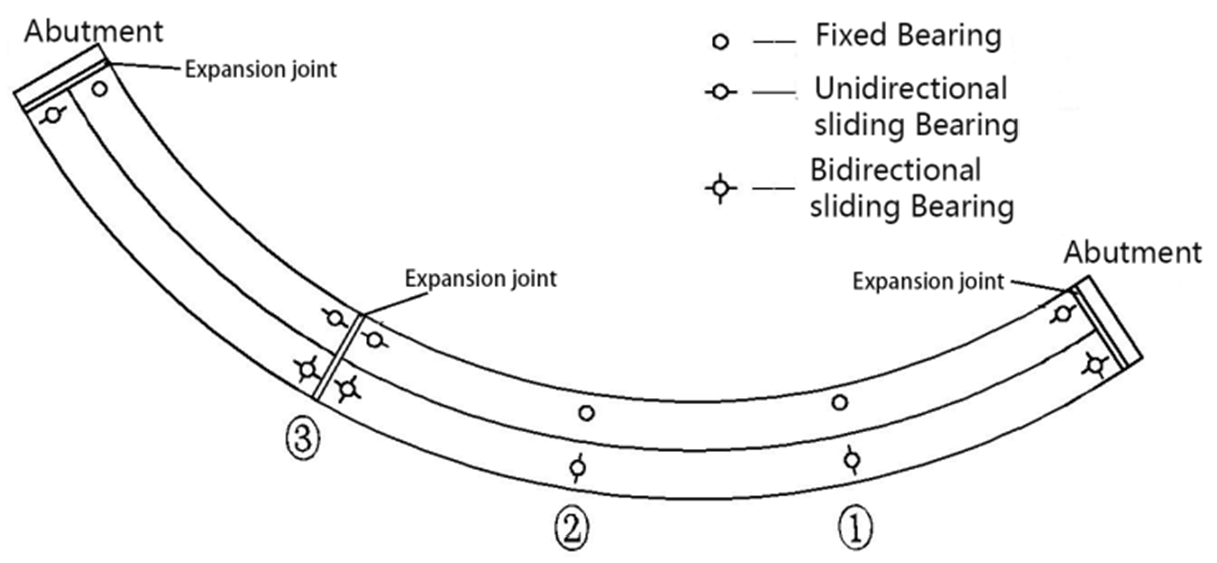

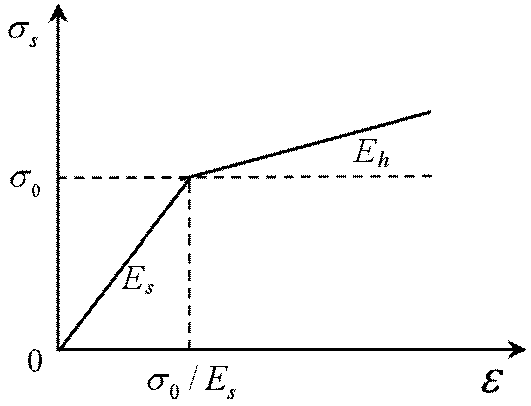
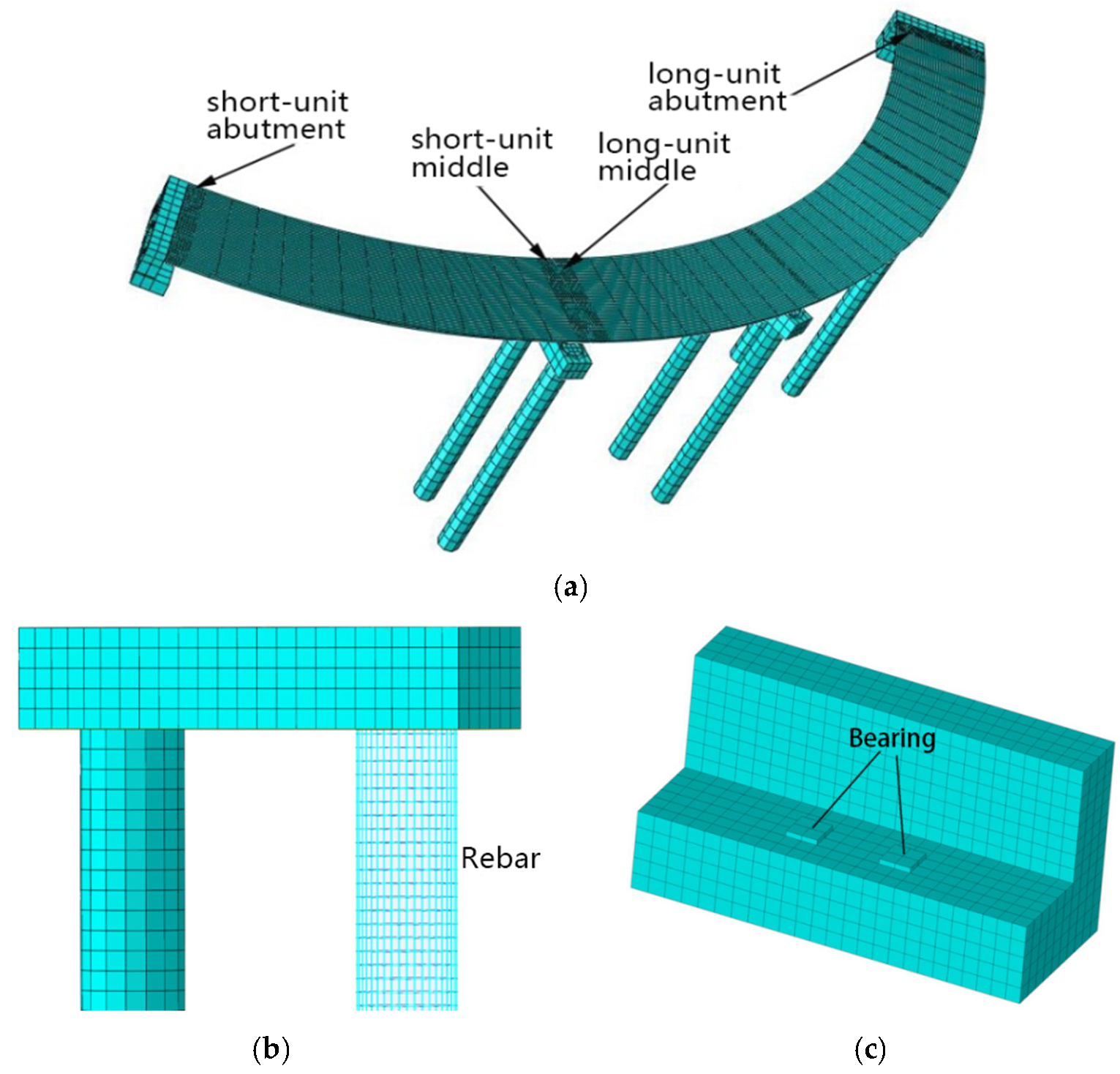
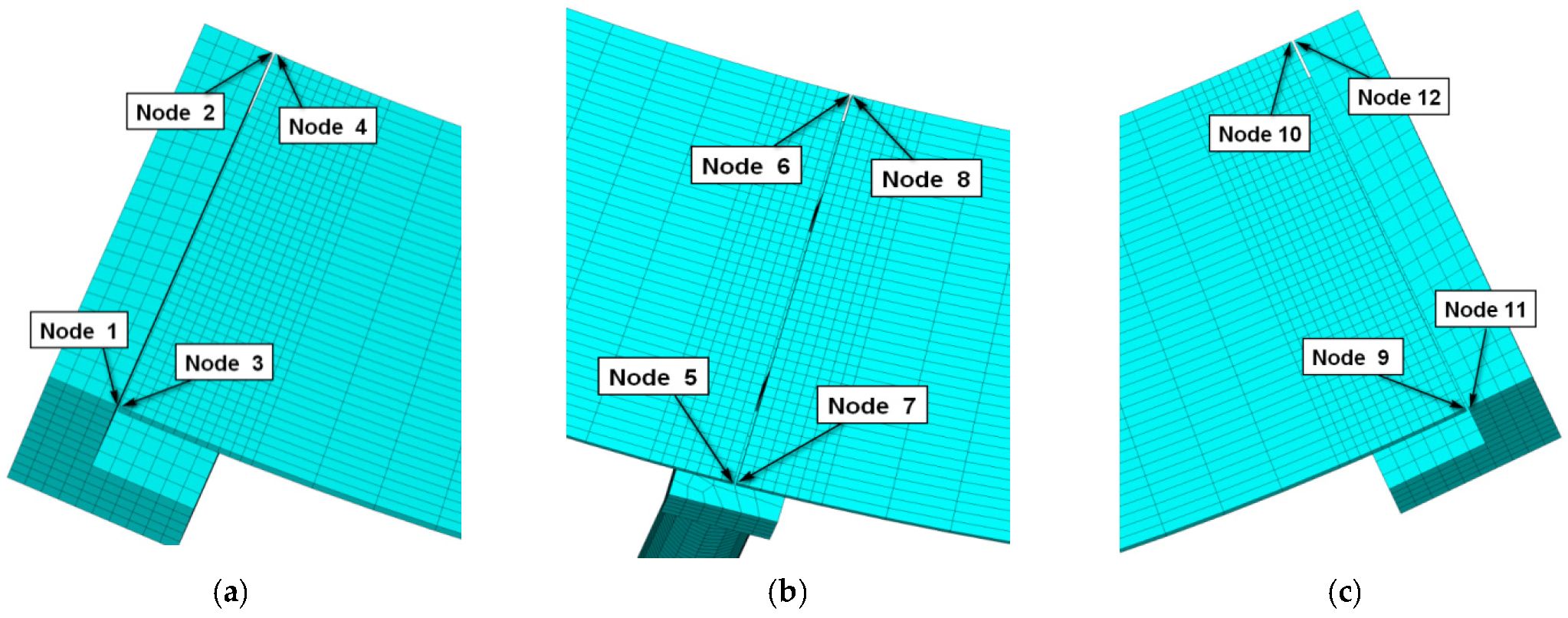
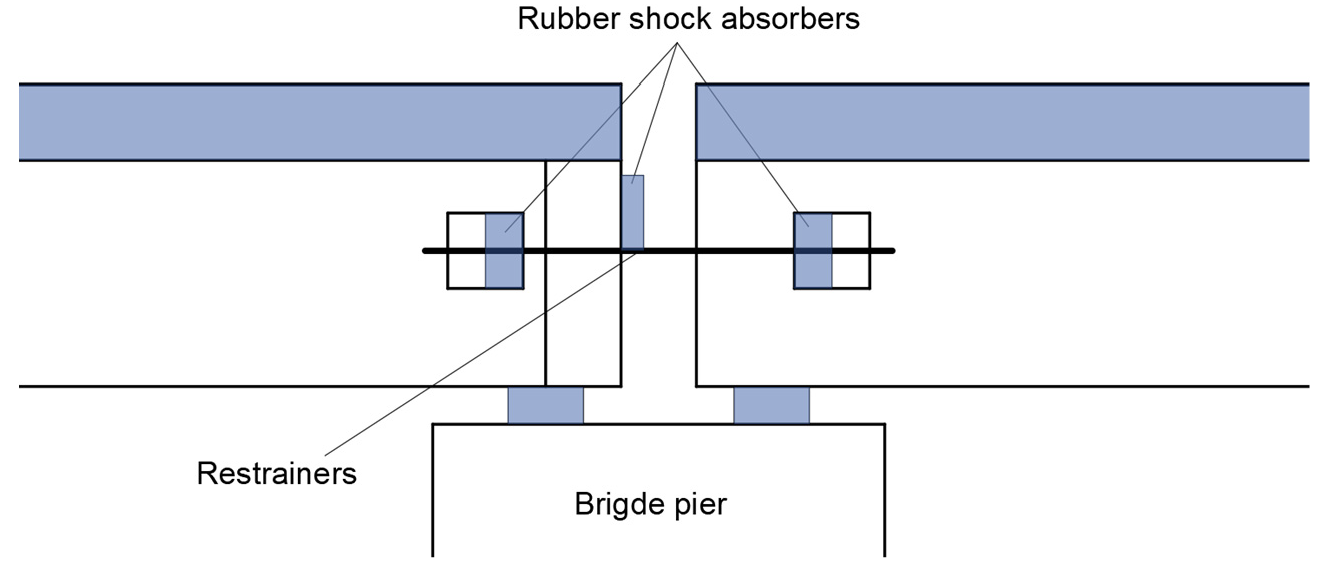

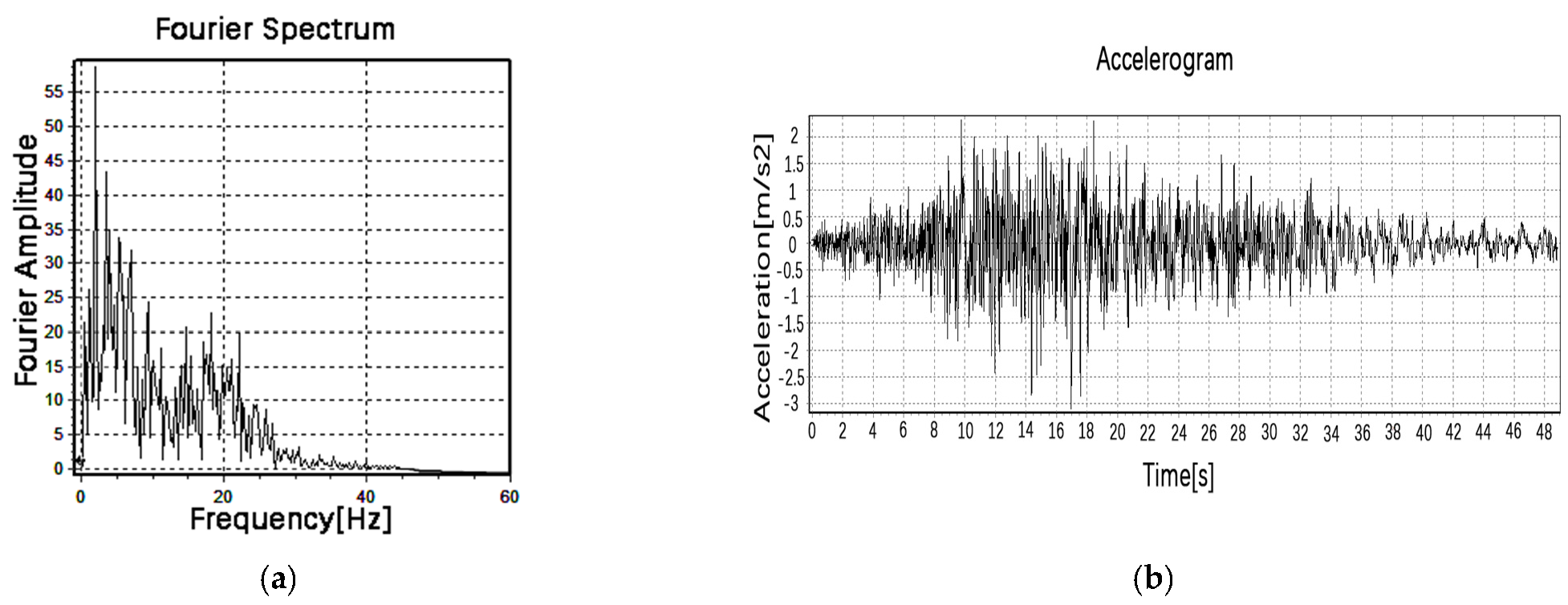


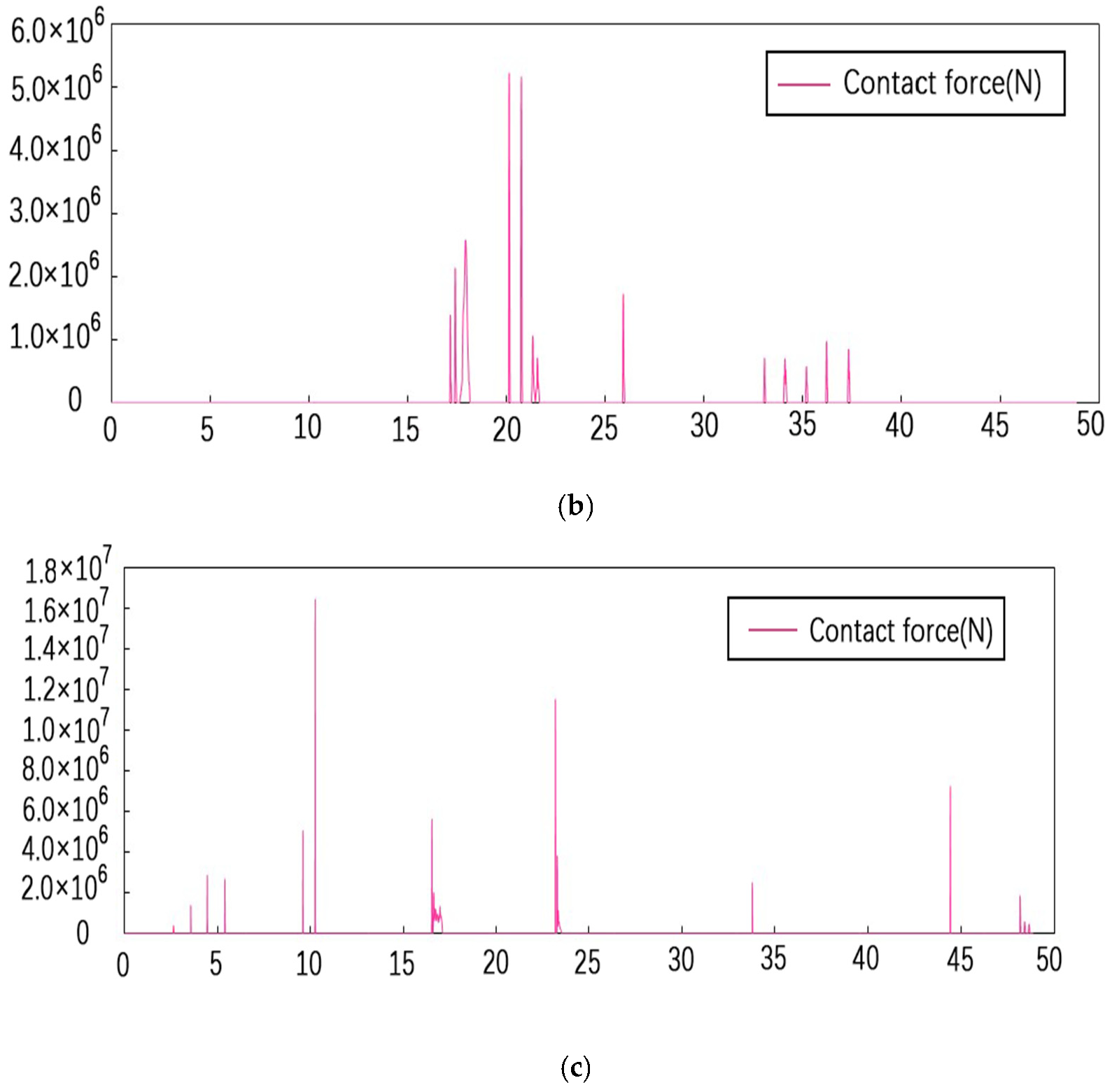
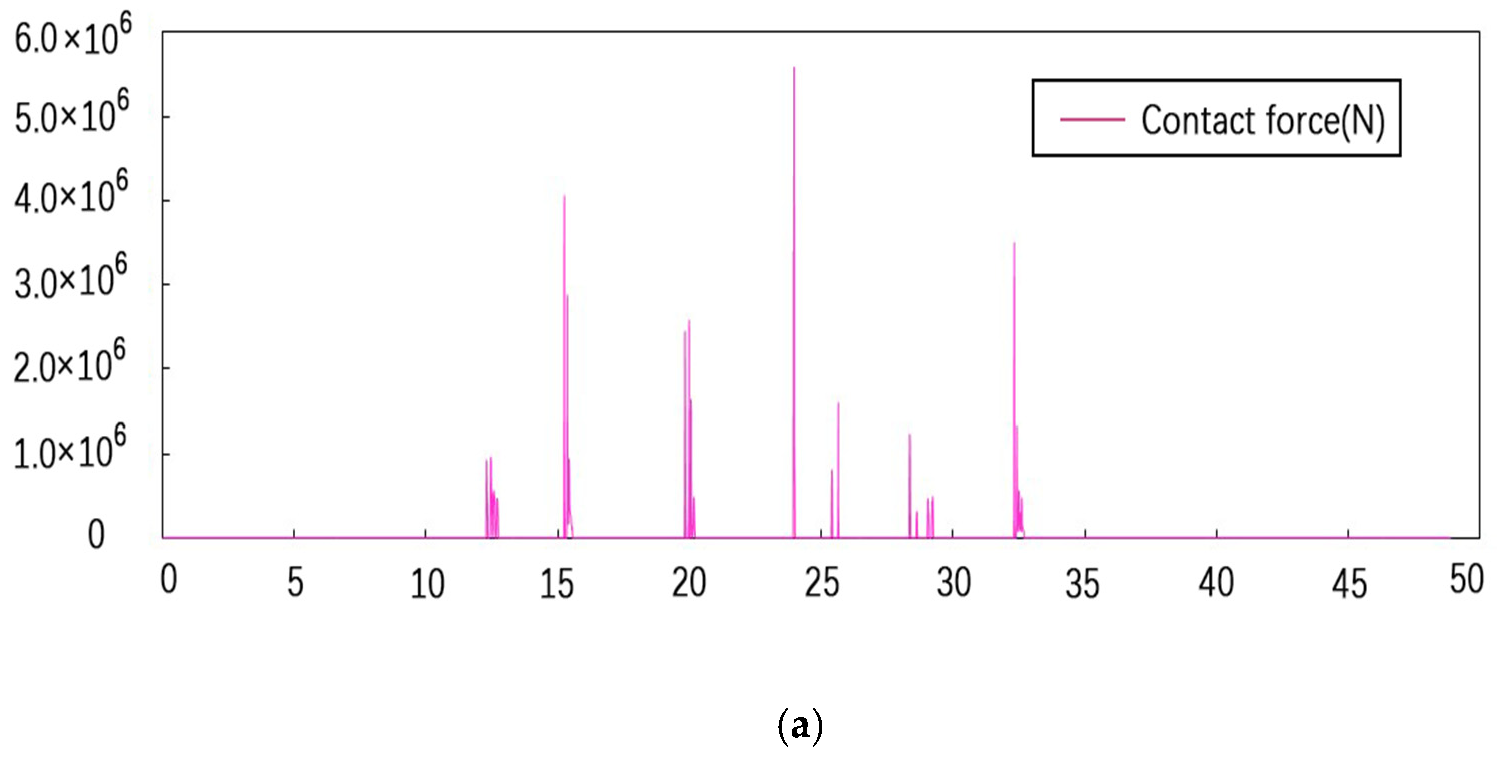
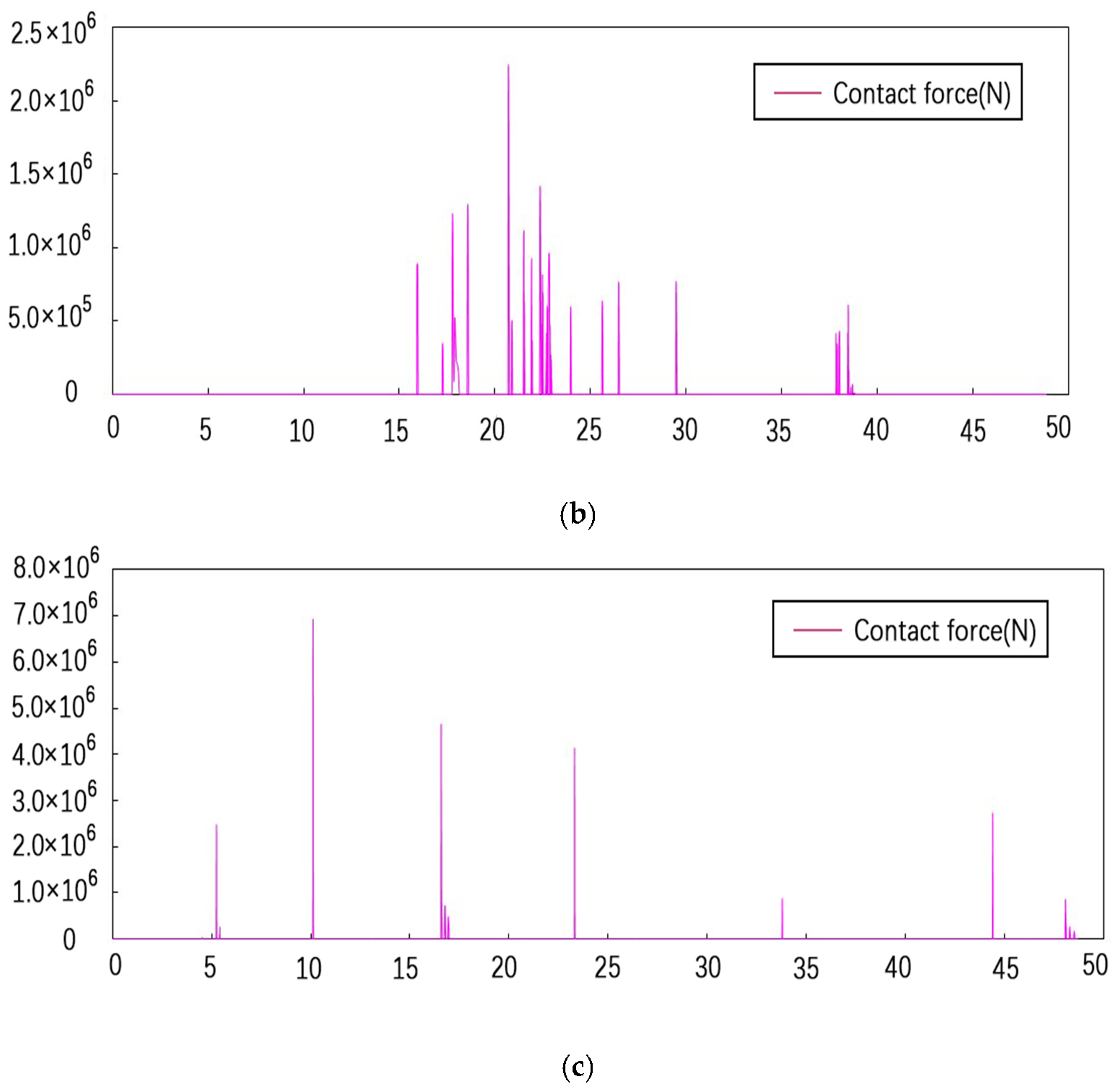
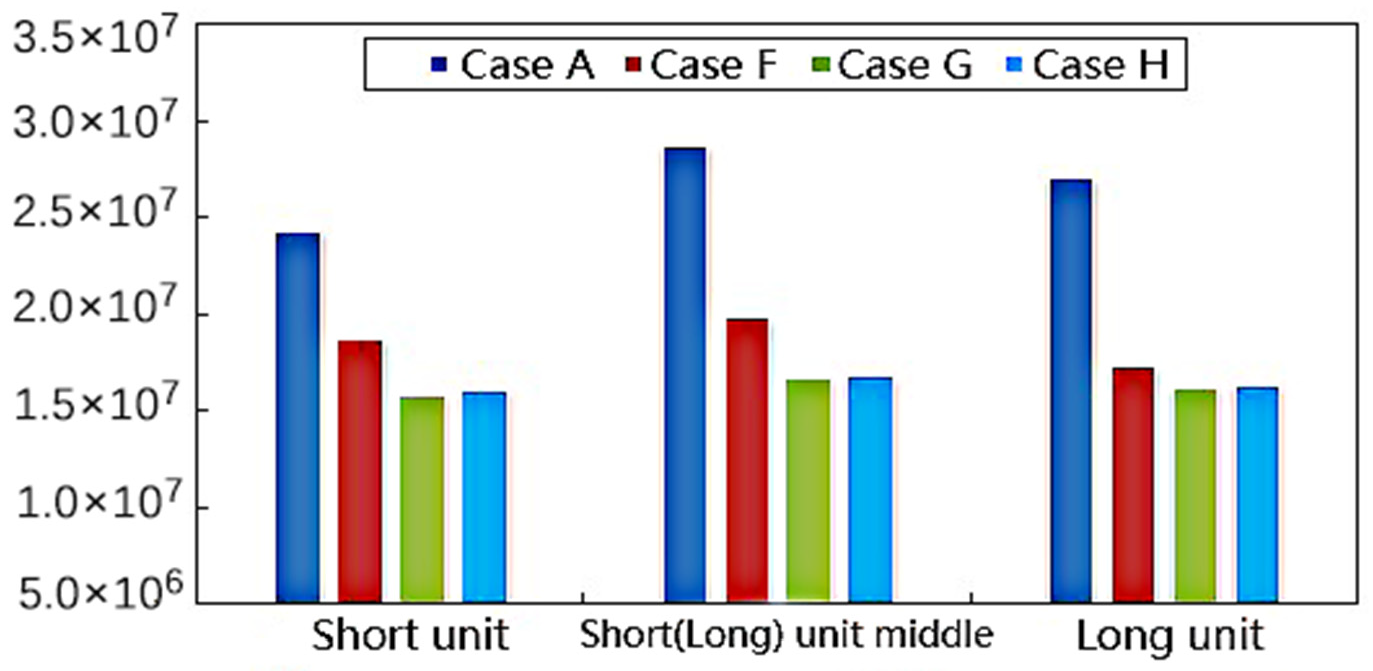

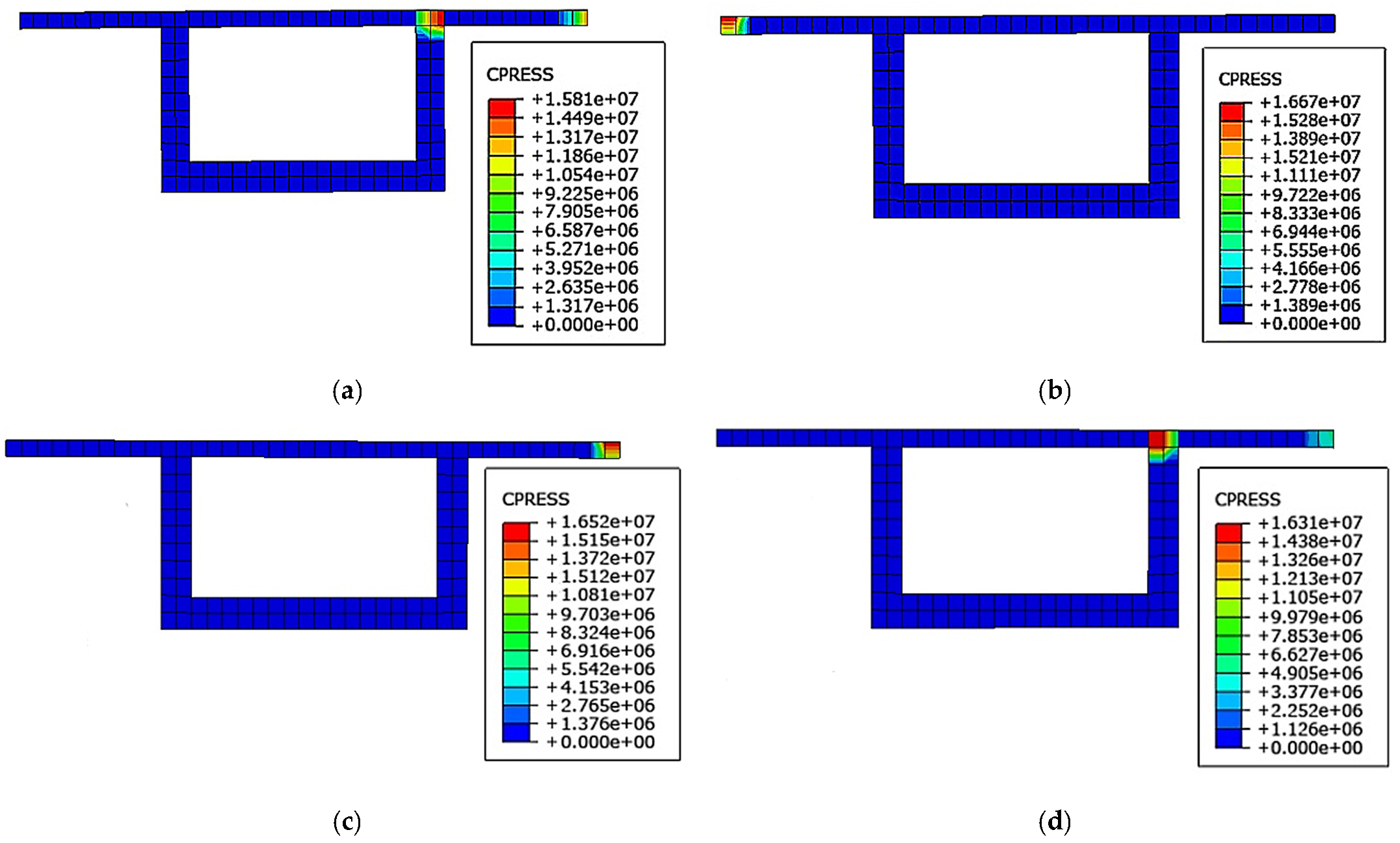


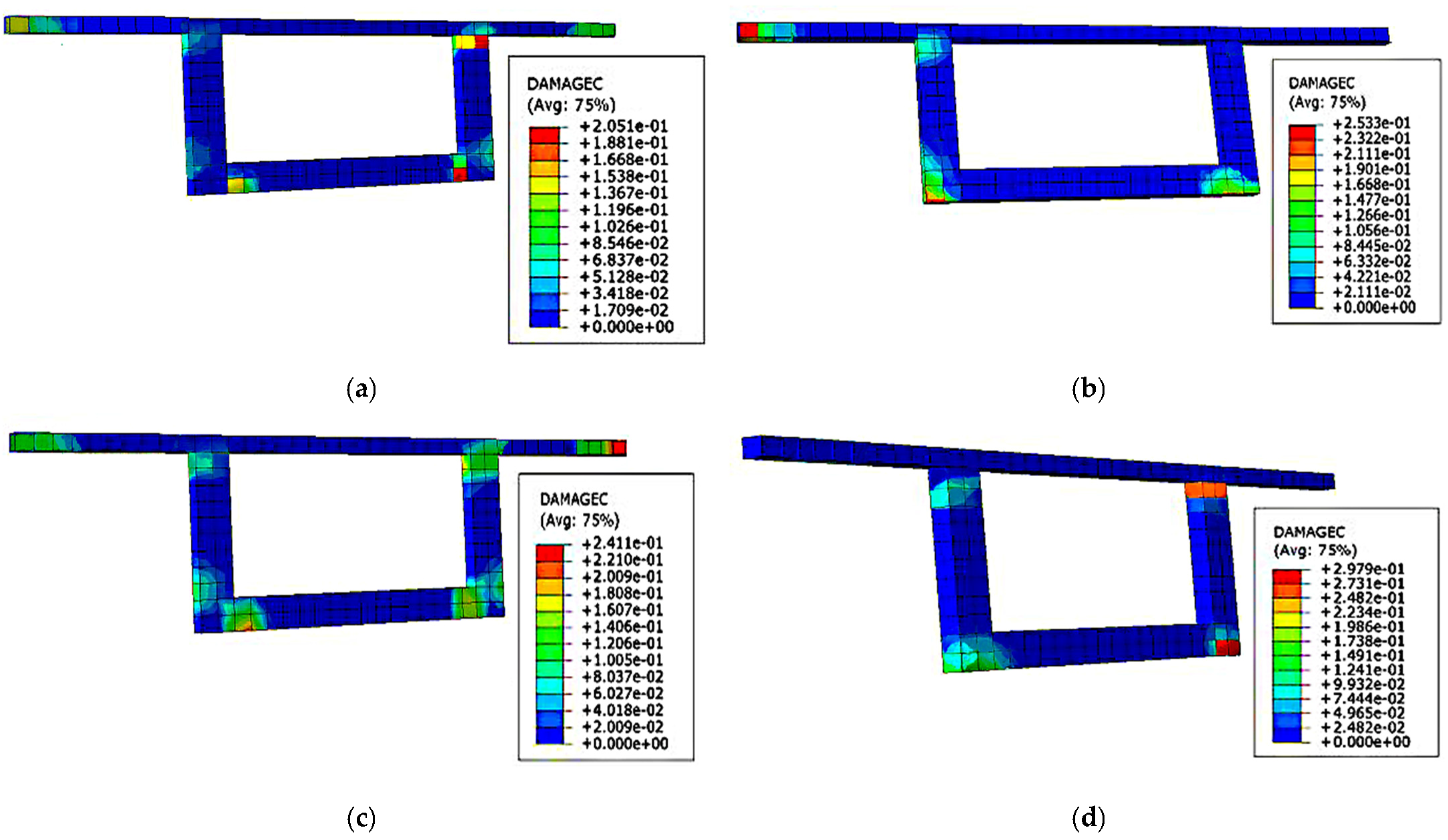

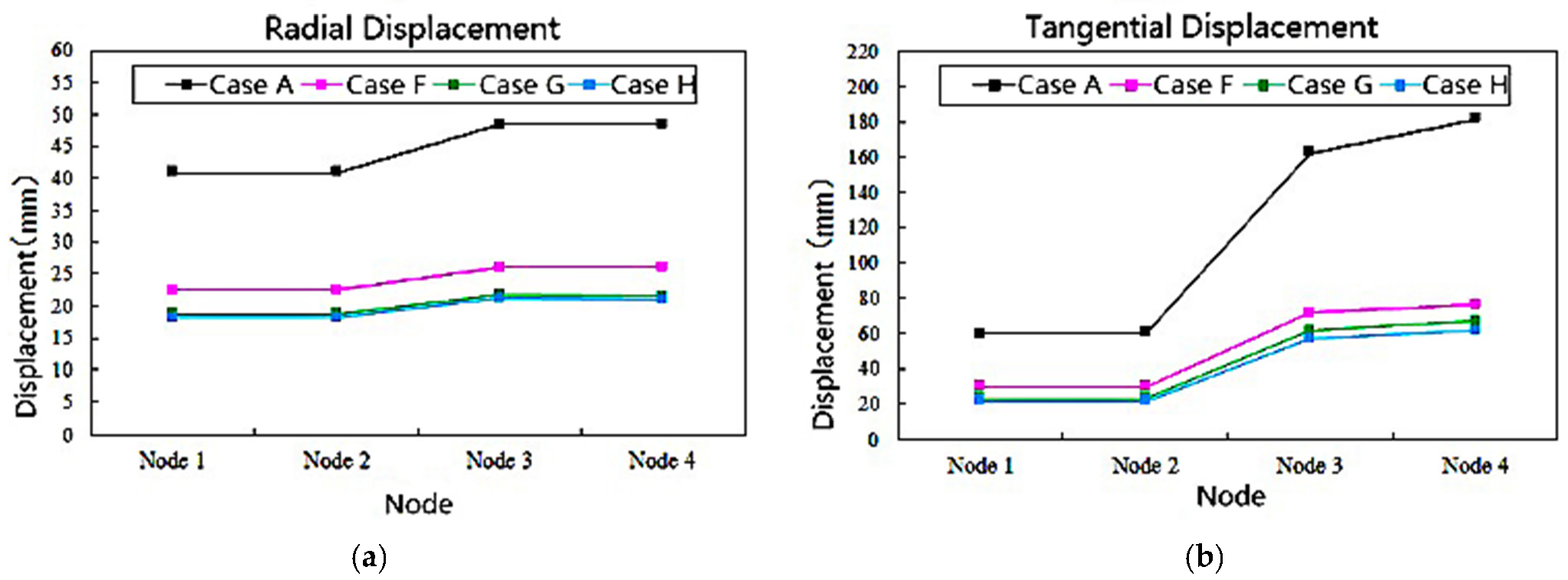

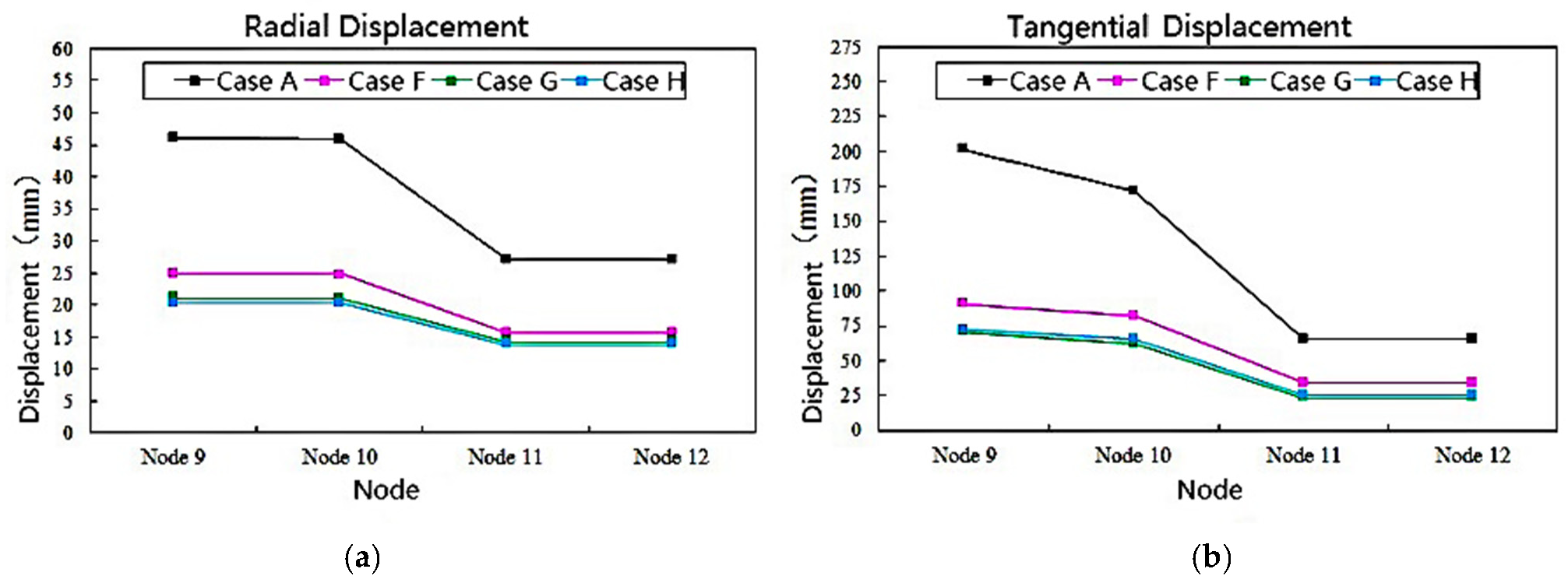
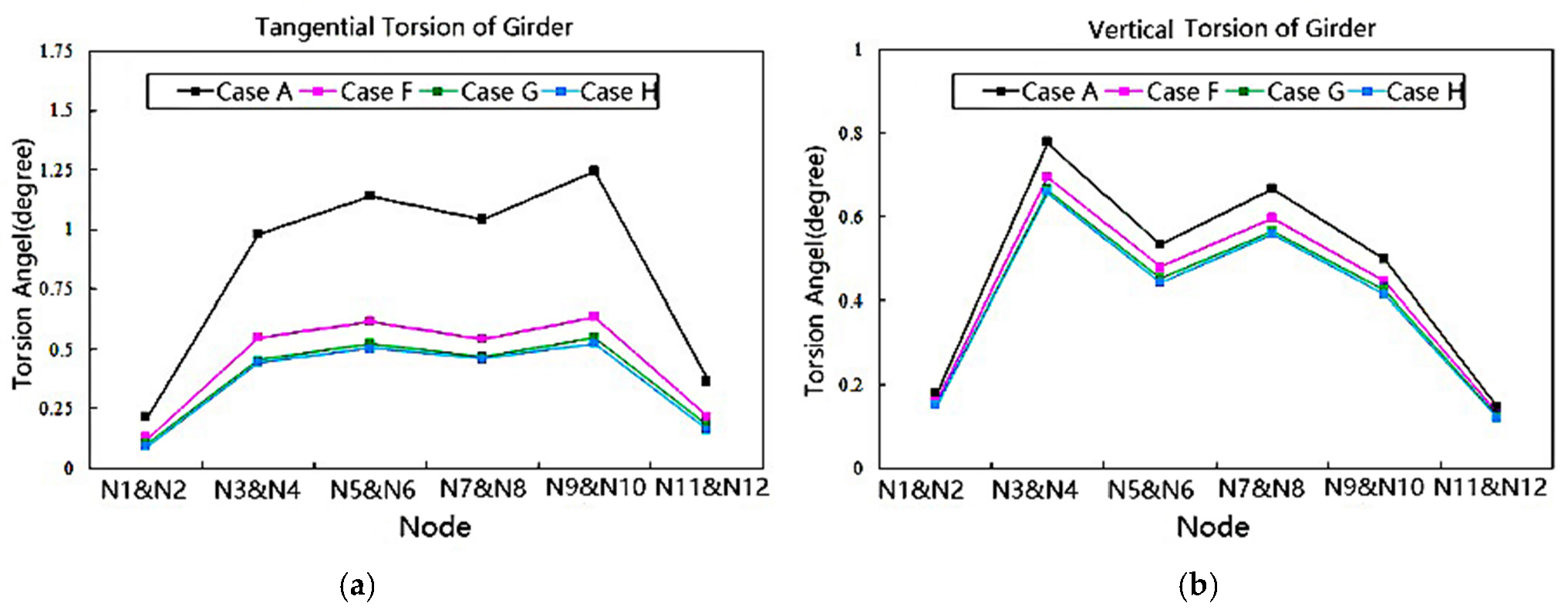
| Compressive Strength (N/mm2) | Inelastic Strain | Compressive Damage Factor | Tensile Strength (N/mm2) | Cracking Strain | Tensile Damage Factor |
|---|---|---|---|---|---|
| 15.5934 | 0.000000 | 0.0000 | 3.0042 | 0.000000 | 0.0000 |
| 17.6459 | 0.000017 | 0.0151 | 1.2476 | 0.000196 | 0.5901 |
| 19.5436 | 0.000040 | 0.0305 | 0.7419 | 0.00033 | 0.7419 |
| 23.1160 | 0.000104 | 0.0643 | 0.5406 | 0.000454 | 0.8092 |
| 24.3117 | 0.000136 | 0.0778 | 0.4326 | 0.000575 | 0.8473 |
| 25.5944 | 0.000177 | 0.0941 | 0.3646 | 0.000695 | 0.8721 |
| 27.7023 | 0.000275 | 0.1274 | 0.3176 | 0.000814 | 0.8895 |
| 29.2035 | 0.000393 | 0.1620 | 0.2829 | 0.000933 | 0.9024 |
| 29.5360 | 0.000431 | 0.1726 | 0.2561 | 0.001051 | 0.9125 |
| 30.1015 | 0.000529 | 0.1978 | 0.2347 | 0.00117 | 0.9205 |
| 30.4000 | 0.000684 | 0.2352 | 0.2026 | 0.001406 | 0.9326 |
| 30.0218 | 0.000861 | 0.2754 | 0.1794 | 0.001643 | 0.9413 |
| 29.0579 | 0.001057 | 0.3175 | 0.1365 | 0.00235 | 0.9571 |
| 27.7390 | 0.001263 | 0.3593 | 0.0478 | 0.010006 | 0.9877 |
| 26.2440 | 0.001475 | 0.3995 | 0.0374 | 0.014126 | 0.9908 |
| 24.6966 | 0.001689 | 0.4372 | 0.0336 | 0.016481 | 0.9920 |
| 23.1748 | 0.001902 | 0.4721 | 0.0180 | 0.040028 | 0.9962 |
| 21.7238 | 0.002113 | 0.5042 | 0.0178 | 0.040616 | 0.9963 |
| Case | Support Type | VED | VFD | SCRB | |
|---|---|---|---|---|---|
| GJZ | LRB | ||||
| A | ● | ○ | ○ | ○ | ○ |
| F | ● | ○ | ● | ○ | ● |
| G | ● | ○ | ○ | ● | ● |
| H | ○ | ● | ○ | ○ | ● |
| Device | Parameter Value |
|---|---|
| GJZ | = 600 × 480 × 100 mm = 38.4 Mpa = 1 Mpa |
| VED | = 4000 KN/m = 600 KN/m/s |
| VFD | = 600 KN/(m/s)0.3 = 0.3 |
| SCRB | = 254238 KN/m = 12711.9 KN/m Yield force: Fy = 2605.7 KN = 360 × 180(360) × 30 mm = 7.84 Mpa |
| LRB | = 21.97 KN/mm = 3.38 KN/mm = 7350 KN/mm Yield force: Fy = 209 KN = 17.75 KN/mm = 2.73 KN/mm = 6000 KN/mm |
Publisher’s Note: MDPI stays neutral with regard to jurisdictional claims in published maps and institutional affiliations. |
© 2022 by the authors. Licensee MDPI, Basel, Switzerland. This article is an open access article distributed under the terms and conditions of the Creative Commons Attribution (CC BY) license (https://creativecommons.org/licenses/by/4.0/).
Share and Cite
Li, Z.; Kang, S.; You, C. Seismic Mitigation of Curved Continuous Girder Bridge Considering Collision Effect. Symmetry 2022, 14, 129. https://doi.org/10.3390/sym14010129
Li Z, Kang S, You C. Seismic Mitigation of Curved Continuous Girder Bridge Considering Collision Effect. Symmetry. 2022; 14(1):129. https://doi.org/10.3390/sym14010129
Chicago/Turabian StyleLi, Zhengying, Shaobo Kang, and Chuan You. 2022. "Seismic Mitigation of Curved Continuous Girder Bridge Considering Collision Effect" Symmetry 14, no. 1: 129. https://doi.org/10.3390/sym14010129
APA StyleLi, Z., Kang, S., & You, C. (2022). Seismic Mitigation of Curved Continuous Girder Bridge Considering Collision Effect. Symmetry, 14(1), 129. https://doi.org/10.3390/sym14010129






